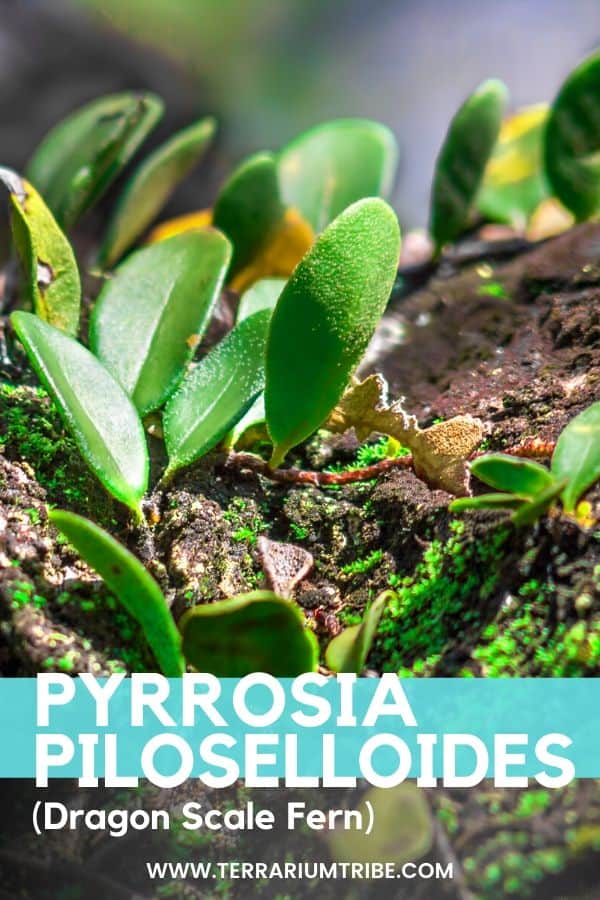Pyrrosia piloselloides is an epiphytic creeping fern with round, fleshy leaves.
In the wild, it’s known to completely blanket trees in overlapping leaves, giving them an armored appearance like dragon scales. Quite unlike scales, however, the contents of the soft, succulent leaves are often used medicinally in native cultures.
The Dragon Scale Fern adapts very well to terrarium settings and will do best wrapped around driftwood branches or mounted to a background.
With its light green colors and soft shapes, it adds a lovely texture to any terrarium environment.

Where to Buy Dragon Scale Fern
See the links below to purchase from reputable terrarium plant shops and marketplaces (may include affiliate links).
Pyrrosia piloselloides Care & Growth
| Plant Type | Fern, epiphyte |
| Lighting | Low – high indirect light |
| Temperature | 65-80°F (18-26°C) |
| Watering | Regular, even moisture |
| Humidity | High humidity (60-90%) |
| Growth | 1-2 inches |
Lighting
Pyrrosia piloselloides has forgiving lighting requirements and will readily grow in both low-light settings and areas of varying indirect sunlight. In heavily shaded areas, you’ll see the normally round leaves elongate and reach towards light sources. So you can use this as a guide.
Watering
The Dragon Scale Fern is an epiphytic species but still prefers moist environments. It may need the occasional misting to keep it happy, but it’ll do well if attached to a consistently moist surface, e.g., tree bark.
Substrate
The Dragon Scale Fern grows best attached to hardscape, but it can likely still grow on a moist substrate if the rhizome is not buried deep and there’s plenty of aeration.
Temperature & Humidity
Native to Malaysia, Singapore, and other Southeast Asia countries, Pyrrosia piloselloides thrives in warm and humid tropical forest environments.
Growth
A very easy grower – under the right conditions – the Dragon Scale Fern will grow to eventually cover any hardscape items that it successfully attaches to.
Propagation
Pyrrosia piloselloides can be propagated via a variety of methods. They tend to reproduce mostly via spores in the wild, but we can do it via stem cuttings or simply dividing a larger plant. Try to separate/cut sections of rhizome with at least 4 or 5 leaves to give them a good chance at thriving on their own.
Varieties & Similar Plants
Pyrrosia is an interesting genus of epiphytic ferns. They come in a wide variety of leaf shapes and sizes, but unlike most ferns, they tend to have succulent leaf qualities.
Some, like P. christii and P. lingua, have long, tongue-like leaves, and others, like P. piloselloides, have round, button-like leaves.
For other button-like ferns, check out the (appropriately named) Button Fern (Pellaea rotundifolia) and Lemon Button Fern (Nephrolepis cordifolia).
Common Problems
The Dragon Scale Fern is generally easy to grow in a terrarium if given a suitable environment and hardscape to attach to. The attachment phase (as the fern is developing its rhizoids) will be the most challenging part, but keep it watered and happy with the occasional misting, and it’ll settle in nicely.
